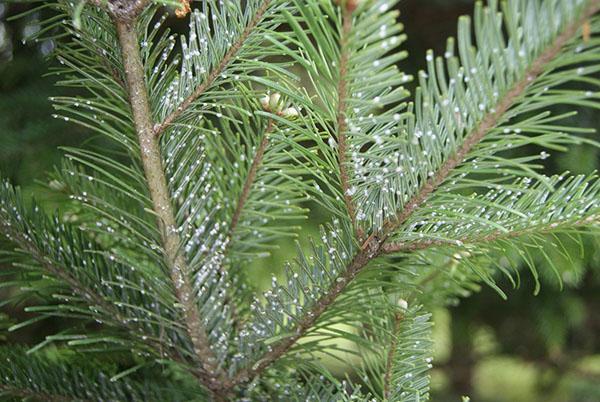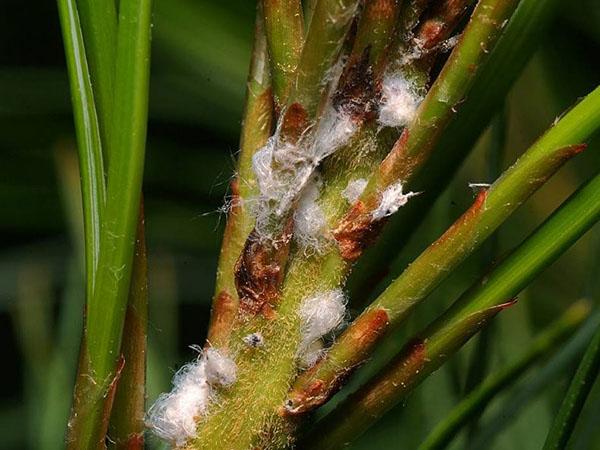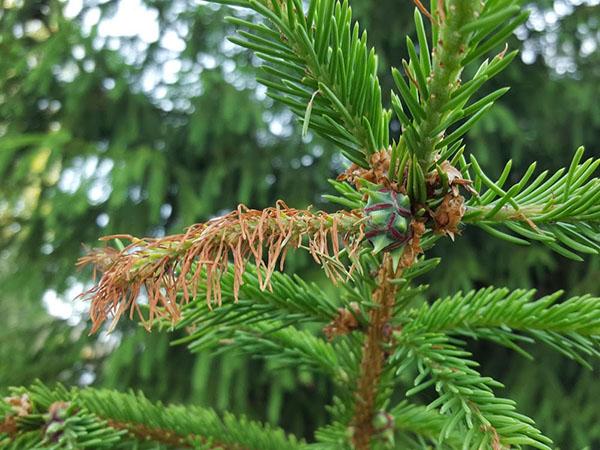What to do if Hermes appeared on conifers

Hermes (scientific name Adelgidae) are microscopic aphids. She settles on coniferous trees, which is why growths (galls) are formed on them. Because of these pests, the needles turn yellow, deform, and stop growing.
Hermes: what is it

Hermes is a whole group of pests, they belong to the group of homoptera. Small insects living on needles, no more than 2 mm in length. The aphid becomes black or brown, the body is elongated, there are antennae on the head.
To protect the spruce from the spread of pests, it is better to plant it away from other coniferous crops (fir, larch). The optimal distance is 600 m.
The pest feeds on juices obtained from needles and shoots. He prefers spruce most of all, and also pine... You can notice the presence of this parasite at the very end of spring by the modification of the needles: they turn yellow, bend, become covered with a whitish bloom. This light fluff also envelops the buds and young shoots. The raid is a shelter, protection of the hermes larvae. If the plant is infected, then in the summer the twigs are overgrown with galls - cones.
Hermes: symptoms of damage and the main types of pest

This sucking parasite is quite difficult to develop. It needs two different trees: larch and spruce. Often these conifers grow close to each other, which ensures full development of the hermes. Insect larvae live on larch, their body is covered with wax and down. They drink all the juices from the needles, causing it to turn yellow, dry, and fall off. Gauls are formed on the trees. At first they have a beige color, which turns first into green and then into brown.
Shoots affected by galls cannot be restored.

Types of Hermes:
- Yellow hermes. One generation of parasites develops in one season. The female feeds on the sap of needles, and then forms an oblong gall, it reaches a length of 20 cm. Formation of a green tint with a red outline. In the middle of it, the female hides eggs, from which larvae appear.
- Late spruce hermes. The female of this pest forms light greenish galls. She prefers buds located at the end of the branches. The insect feeds on sap, produces saliva, which is involved in the formation of a seal. Spruce Hermes lays eggs in autumn. In the spring, larvae appear of them, which leave the gall in summer and spread throughout the coniferous tree. The development of the parasite and its reproduction occurs on the same tree; lateral shoots are more often affected.
- Subcrustal spruce hermes. A distinctive feature of this spruce parasite is the absence of galls. Insects are wingless, they live only on spruces, located on the bark of branches or a tree trunk. It is here that a white bloom forms.
Another well-known species of the spruce parasite is green hermes. The female equips a gall, similar to a ball, 2 or 3 cm in size and lays eggs there. In the summer months, winged insects fly out of it, which rush to the larch to reproduce.
Methods of dealing with hermes

It is important to understand that hermes is not an infection, but an insect, a parasite. Therefore, appropriate methods of struggle should be selected. The first step is to inspect the tree, remove all the shoots where galls are found, and burn them. The procedure is carried out in early or mid-spring, until the larvae have grown.The next step is to wash the wood. It is necessary in order to remove insects using the pressure of water. Only after that, treatment with drugs is carried out. You can spray the spruce with a solution of mineral oil at the rate of 150 ml for every 5 liters of water. If this does not help, then the ate is treated with insecticides. Confidor Maxi, Balazo are suitable, Caesar, Mospilan can be used. Aktara gives a good effect, Prestige, Commander.
When the larvae emerge from the gall, it remains on the branches for a rather long time, gradually dries out.
The insecticide solution is prepared strictly according to the instructions indicated on the package of the drug. The volume is calculated based on the number of coniferous plantations, and the frequency of spraying is selected depending on the degree of pest infestation. Insecticides have a stronger effect on adults that migrate, as well as on "vagrants".
To surely eliminate these parasites, the treatment is carried out several times during the season:
- In early spring and late autumn, to exterminate wintering Hermes.
- In the third decade of April or in the first week of May, when tree shoots and, accordingly, larvae are actively developing.
- First decade of July. At this time, galls ripen, wingless insects appear.
- With the onset of August. This treatment is aimed at getting rid of the nymphs that come out of the Gauls.
It is best to use different insecticides alternating between applications. Processing is not stopped until the whitish "fluff" on conifers disappears.
Measures to prevent and increase the resistance of trees to insects
To prevent damage to conifers at their summer cottage, certain measures must be taken.
Ways to increase tree stability:

- Do not plant trees in open areas and places that have drafts. It is also not recommended to grow trees in areas where there is a threat of flooding.
- Grow a tree in loose soil, the soil must be fertile and necessarily slightly acidic. If necessary, acidify the soil with peat or fallen needles.
- Within a year after planting the spruce, it is watered not only at the root, but also sprayed the entire crown.
- To improve rooting, when planting, seedlings must be treated with Kornevin or Radifarm.
- Three times a season, with breaks of up to 20 days, coniferous crops are treated with means to increase immunity. Epin, Sodium humate, as well as Megafol are suitable.
- Around the trunk, the soil is covered with crushed pine bark.
- The crown is sprayed with fertilizers for conifers (Iovofert, Reakom-needles).
During the acquisition of seedlings, they must be examined. If insects are found, then they must be destroyed before planting the tree, and the branches with galls should be cut off.
If you know what kind of pest hermes is and methods of dealing with it, then you can safely grow conifers in your area.